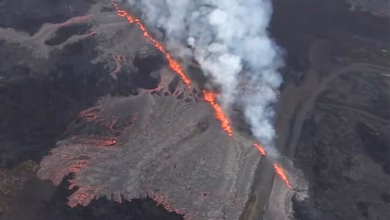Seismic ripples observed in the oldest known spiral galaxy

Astronomers have captured a new snapshot of the ancient spiral galaxy BRI 1335-0417. The research is providing valuable insights into the formation of early galaxies and shedding light on the origins of our own Milky Way.
Dating back more than 12 billion years, BRI 1335-0417 is the oldest and farthest known spiral galaxy in our universe.
Spiral galaxy BRI 1335-0417
According to study lead author Dr. Takafumi Tsukui, a state-of-the-art telescope called ALMA allowed the experts to look at this ancient galaxy in much greater detail.
“Specifically, we were interested in how gas was moving into and throughout the galaxy,” said Dr. Tsukui. “Gas is a key ingredient for forming stars and can give us important clues about how a galaxy is actually fueling its star formation.”
The research stands out for its unique findings on the galaxy’s disk. The team captured the motion of gas around BRI 1335-0417.
They also identified the formation of a seismic wave, a phenomenon that has never been observed within such an early galaxy.
Dr. Tsukui compared the movement of the spiral galaxy’s disk to ripples spreading on a pond, suggesting the disk’s vertical oscillation might be due to external factors such as new gas streaming into the galaxy or interactions with smaller galaxies.
These external influences bombard the galaxy with fresh fuel for star formation, a key factor in understanding galactic evolution.
Evolution of early spiral galaxies
“Additionally, our study revealed a bar-like structure in the disk. Galactic bars can disrupt gas and transport it towards the galaxy’s center. The bar discovered in BRI 1335-0417 is the most distant known structure of this kind,” said Dr. Tsukui. “Together, these results show the dynamic growth of a young galaxy.”
The images seen through the ALMA telescope in the present day are a throwback to the galaxy’s early days — when the Universe was just 10 percent of its current age, noted the researchers.
Study co-author Professor Emily Wisnioski pointed out the unique attributes of early galaxies like BRI 1335-0417.
“Early galaxies have been found to form stars at a much faster rate than modern galaxies. This is true for BRI 1335-0417, which, despite having a similar mass to our Milky Way, forms stars at rate a few hundred times faster,” said Professor Wisnioski. “We wanted to understand how gas is supplied to keep up with this rapid rate of star formation.”
“Spiral structures are rare in the early Universe, and exactly how they form also remains unknown. This study also gives us crucial information on the most likely scenarios.”
“While it is impossible to observe the galaxy’s evolution directly, as our observations only give us a snapshot, computer simulations can help piece the story together.”
The ALMA telescope
As mentioned above, the Atacama Large Millimeter/submillimeter Array (ALMA) is a revolutionary astronomical observatory and one of the largest and most complex ground-based astronomy projects.
Location
ALMA is located in the Atacama Desert of northern Chile, at an altitude of about 5,000 meters (16,500 feet). This high and dry location is ideal for millimeter and submillimeter wavelength observations, which are otherwise absorbed by moisture in the Earth’s atmosphere.
ALMA is an international partnership involving North America, Europe, East Asia, and Chile, showcasing global cooperation in the field of astronomy.
Research and discoveries
The array consists of 66 high-precision antennas, which can be positioned up to 16 kilometers apart.
This configuration allows astronomers to achieve a resolution and sensitivity that were previously unattainable in millimeter/submillimeter astronomy.
ALMA is designed to study some of the oldest and most distant objects in the Universe. It has contributed significantly to our understanding of star formation, planetary systems, galaxies, and the early Universe.
Its high-resolution capabilities also make it ideal for detailed imaging of molecular gas and dust in the Universe, essential for understanding the process of star and planet formation.










